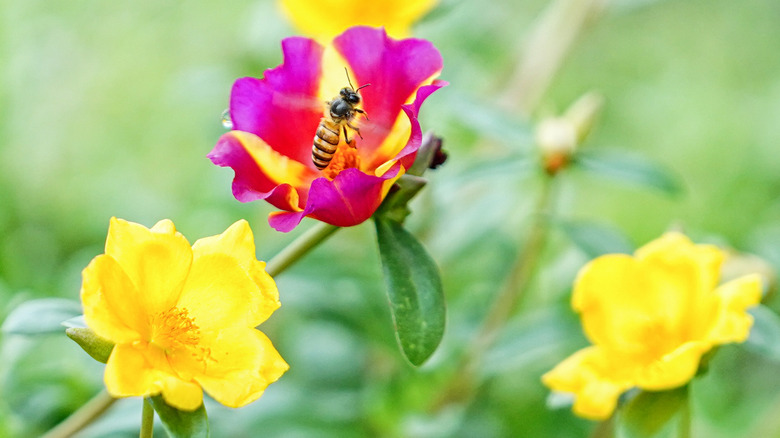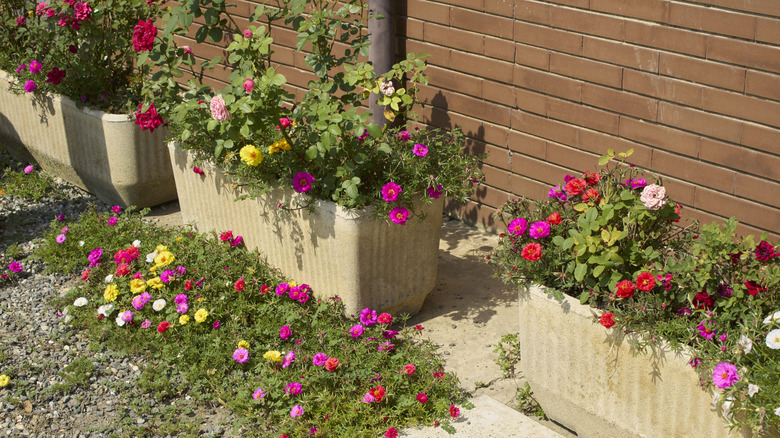The Fast-Growing Flower Pollinators Love That Doubles As A Stunning Ground Cover
When it comes to deciding what to plant in your garden, sometimes simple really is best — not every plant needs to be tall or dramatic to make a statement. Moss rose (Portulaca grandiflora) is a perfect example of one such plant. This low-growing, sun-loving annual proves that ground covers can be just as eye-catching as flashier bloomers, especially in the heat of summer when its vibrant flowers take center stage. With dense foliage and bright, cup-shaped blooms in vivid shades of pink, orange, red, white, and yellow, moss rose is a garden flower that will have summer beds bursting with color, while supporting pollinators along the way.
Moss rose doesn't just look good, it's incredibly practical too. It thrives in the heat, can tolerate dry spells, and grows well in all kinds of soil, whether it's chalky, sandy, or loamy. It's also a fast grower, which makes it a great option if you're trying to cover bare spots in the yard quickly. Moss rose's dense growth means it can suppress weeds, lock in moisture, and retain soil nutrients. That moisture and nutrient-retaining quality means that if you have a sunny spot in your garden where it might be hard to grow anything due to dry soil, moss rose could give other plants a helping hand.
Why pollinators love moss rose
Pollinators love bright, open blooms, and moss roses deliver plenty of them. These cheerful flowers open with the sun (you'll notice they stay closed at night and on cloudy days), which aligns perfectly with the hours when pollinators like bees and butterflies are most active. That makes these flowers a reliable stop for insects during the hottest parts of the day.
One of the best things about moss rose is its long flowering season. Starting in late spring and continuing right through early fall, it helps bridge the gap between early-blooming spring flowers and the often-scarce blooms of late summer. This is great for pollinators, who rely on continuous access to nectar throughout the warmer months.
As the moss rose also holds up well in hot, dry conditions, its ability to thrive when water is limited means it keeps producing nectar-rich flowers even in drought-prone areas. If you're looking to support pollinators with something low-maintenance and reliable, moss rose should be your go-to.
How to grow moss rose in your garden
The great thing about the moss rose is that it's a flower that even the worst gardeners can handle. If you're wondering how to grow portulaca plants, know that moss rose is hardy in USDA Zones 3 through 11, and thrives with minimal effort, especially in sunny spots with well-drained soil. You can start moss roses from seed once the weather begins to warm, and transplant to your garden after the last frost. Location is everything when it comes to helping moss rose thrive. This plant doesn't like soggy soil, so aim to plant it in drier areas of your yard. It's also right at home in rock gardens, gravel beds, or containers. Once planted, it spreads quickly, so give it space, about 6 to 12 inches between plants should do the trick. It often self-seeds, returning year after year with little intervention.
Be sure to keep an eye out for aphids and slugs among these plants in your garden, as these pests are often attracted to them. While moss rose is drought-tolerant, a bit of water during extended dry spells helps keep this flower blooming — but avoid overwatering this shallow-rooted plant as this can cause root rot.


